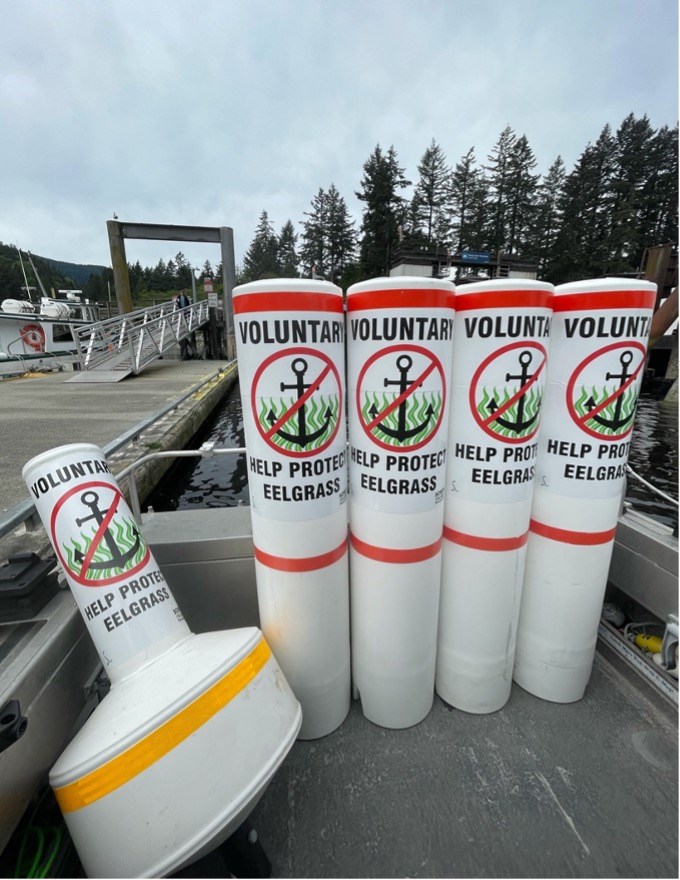Five new buoys will bob on the surface of Gibsons Harbour with an important mission: protecting the eelgrass below.
The installation will create a 315-metre long voluntary no-anchor zone near Armours Beach, where a healthy eelgrass bed has seen a 23 per cent decline between 2013 and 2019. It’s part of the Healthy Harbour project between the Town of Gibsons and Nicholas Sonntag Marine Education Centre (NSMEC), with help from SeaChange Marine Conservation Society.
“This is part of a transboundary effort to educate boaters to avoid anchoring in eelgrass areas,” regional SeaChange coordinator Fiona Beaty said. While there won’t be enforcement of the zone, the project hopes to work with the community and local elected officials to encourage protecting the habitat.
Eelgrass is an important natural asset, because it helps protect the shoreline from coastal erosion and wave action, and also sequesters carbon, Jenny Wright of NSMEC told Coast Reporter. The eelgrass beds also serve as a habitat for nearly 400 marine species, from juvenile salmon and herring to crabs seeking shelter when they’re molting and until their shell hardens.
While much of Howe Sound has steep, rocky shorelines, West Howe Sound’s shallow nearshore areas allow the eelgrass root systems to grow with good sunlight conditions and the proper kind of sediment.
But eelgrass faces two predominant threats: coastal development and nearshore human activities, and climate change. There’s been a global average decline of seagrass beds by around 35 per cent because of human activity, with a projected annual decrease of 1.4 per cent going forward. SeaChange coordinator for the Sechelt area, Dianne Sanford, said the Gibsons Harbour eelgrass was first mapped in 2004, and since then has seen a decline. There’s also been a reduction in density, Beaty said.
“But it’s still really healthy and worth protecting and trying to restore,” Beaty said.
“We don’t want to lose more,” Sanford added.
The new voluntary no-anchor zone “is addressing that bottom contact effect and really hoping to reduce the fragmentation of the eelgrass meadows that occurs every time the anchor is dropped,” Beaty said. Fragmentation can make the eelgrass bed vulnerable to disease, storms and waves, leading it to become increasingly sparse.
The first Canadian voluntary no-anchor zone was established with five marker buoys in Bowen Island’s Mannion Bay in early 2021, and the municipality purchased two more buoys that fall to expand the zone. Since then, various creatures have been recorded exploring the new eelgrass bed, which Beaty said is encouraging.
Second such zone in Howe Sound
The zone in Gibsons Harbour will be the second in Howe Sound. While there are no immediate plans for a similar zone in Sechelt Inlet, recent eelgrass transplants in those waters have likewise been successful.
The buoys will be installed by divers in the next few months with a midline float that will help prevent the rope between the marker and the anchor from rubbing the seafloor. The anchors will be placed deeper than the eelgrass bed.
On Feb. 18, the NSMEC at the Gibsons Public Market is hosting a free day for all to visit their aquarium. Alongside their usual exhibit, information about the voluntary no-anchor zone will be available next to the eelgrass display.
More information about the zone will be presented during a virtual storytelling event on Feb. 22. NSMEC and SeaChange will co-host “Marine Memories” between 6 p.m. and 7:30 p.m.,to raise community awareness and share stories about Gibsons Harbour’s past, present and future. The two organizations will also welcome feedback from the community about the location of the buoys.
Event information can be found on Facebook at facebook.com/events/488791772666718 and attendees can register on Zoom.


